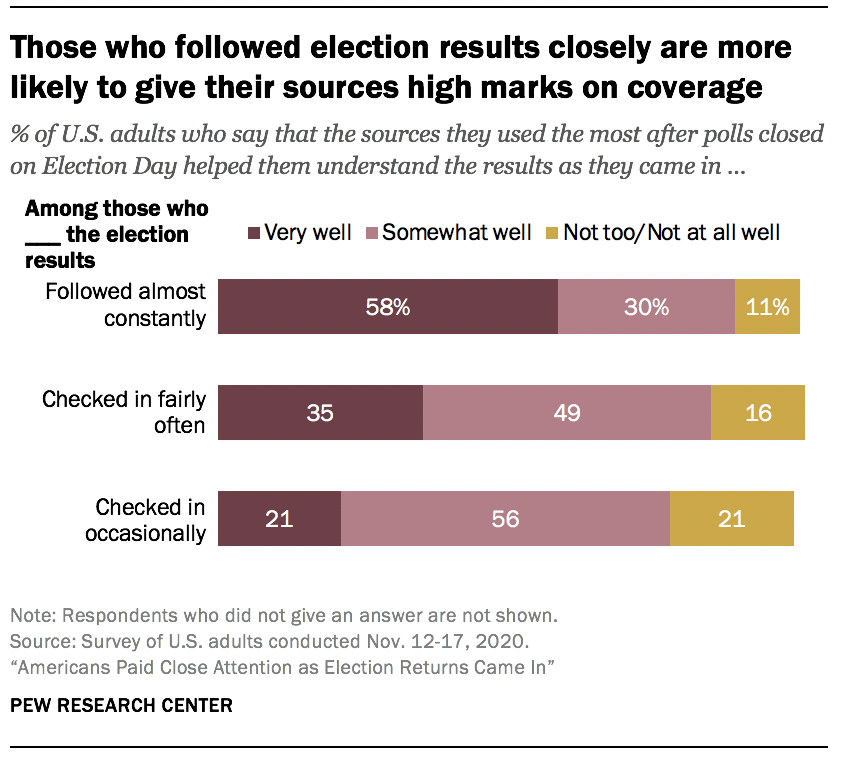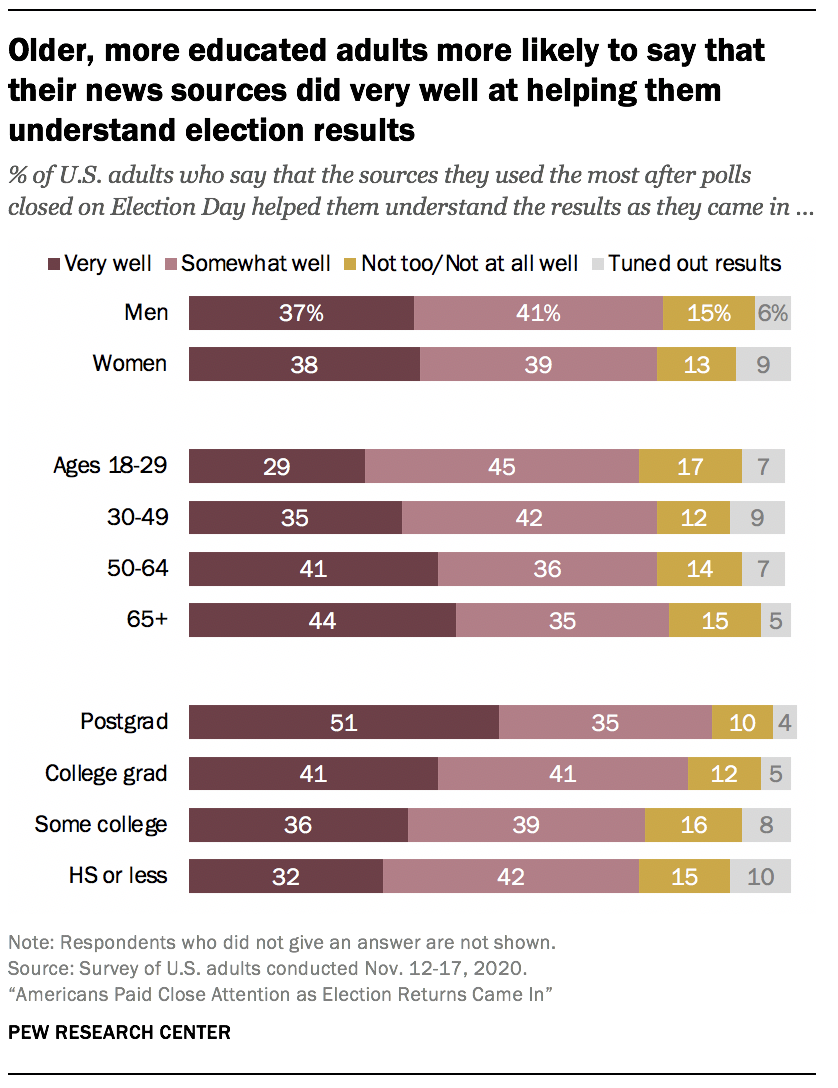Americans generally give the news media high marks for helping them understand the returns for the presidential election as they came in. But within these generally high marks, several areas of difference emerge.

One clear distinction emerges along party lines. Just over half of Democrats and independents who lean Democratic (54%) say the sources they used most after the polls closed did very well in helping them understand the results. Another 34% say they did somewhat well. But only about two-in-ten Republicans and independents who lean Republican (21%) say their sources did very well, while 46% say their sources did somewhat well. About four times as many Republicans (23%) as Democrats (6%) say those sources did not too well or not at all well helping them understand the results.
Americans’ degree of engagement in following election returns as they came in also comes into play in how they evaluated their sources’ ability to help them understand those results.

Americans who say they followed the results of the presidential election “almost constantly” after polls closed on Election Day are more likely than those who followed less closely to say the news sources they used most did a good job of helping them understand those returns as they came in.
About six-in-ten U.S. adults who followed the results almost constantly (58%) say the sources they used most did very well helping them understand those results. The same is true of about one-third of those who say they checked in on the returns fairly often (35%). Continuing the downward slope, 21% of U.S. adults who checked in occasionally give their main sources the highest marks at helping them understand the results. It is worth noting that some of these differences get made up by the portion in each group who say their sources did “somewhat” well. The percentage of those who say their sources did not do too well or not at all well ranges from 11% among those who followed almost constantly to 21% in the group that checked in occasionally.

Within each party, those who spent the most time following the returns are the most likely to say their favorite sources did very well. But the differences between parties remain large.
Indeed, 77% of Democrats who followed returns almost constantly say their most-used sources did very well helping them understand the returns, with almost all the rest (21%) saying those sources did somewhat well. Among Democrats who checked in fairly often, the percentage saying their favorite sources did very well slid to 50%, with almost the same share (46%) saying those sources did somewhat well. For Democrats who checked in occasionally to follow returns, the percentage saying their sources did very well falls to 27%, with 55% saying they did somewhat well and 17% saying they did not too well or not at all well.
About a third of Republicans who followed returns almost constantly (32%) are the most likely in their party say their sources did very well, higher than Republicans who were following the results less closely, but far lower than the Democrats paying the same amount of attention. Another 43% in that group say those sources did somewhat well, and 24% say not too well or not at all well. Of Republicans who followed the returns fairly often, 20% say their most-used sources did very well in helping them understand, less than the 27% who say those sources did not too well or not at all well. Roughly half (53%), however, say those sources did somewhat well.
And among Republicans who checked in occasionally, 16% say their favorite sources did very well, compared with 57% who say they did somewhat well and 25% who say they did not too well or not at all well.
Americans who mainly turned to their social media feeds for election results did not feel well-served

U.S. adults who mainly turned to national network news sources, cable TV news sources or news websites or apps for election night returns offered similarly positive assessments of how those sources did helping them understand the returns. More negative assessments come from those who primarily relied on their social media feeds to follow the results.
Just under half (46%) of U.S. adults who turned most to cable news outlets (such as CNN, Fox News or MSNBC) to follow the results say their sources did very well at helping them understand the results. About four-in-ten (39%) say they did somewhat well, and 15% say they did not do too well or not at all well.
Results were quite similar among Americans who turned to network TV news outlets (such as ABC, CBS, NBC or PBS). In that case, 43% say their main sources did very well helping them understand the returns; another 46% say they did somewhat well; and 12% say they did not too well or not at all well.

Among those whose primary sources were news websites or apps, the results were virtually the same – 43% say their main sources did very well; 46% say somewhat well; and 11% say not too well or not at all well.
The outlier, however, is the group that mostly used social media feeds to follow the election returns. Far fewer (22%) in that group say that their main sources did very well in helping them understand the results, while 27% say they did not too or not at all well. That 27% is roughly double that of any other group. Still, the largest segment of the group, 49%, say their main sources did somewhat well.
As with their media assessments overall, Republicans who turned most to each of these pathways gave their sources lower marks than Democrats who turned to those pathways. Large gaps emerge among partisans who relied most on cable and network TV. About two-thirds of Democrats (including leaners) who turned most to cable news outlets for election results (68%) say their main sources did very well. That was true of just 22% of Republicans (including leaners) who relied most on cable TV. And 60% of Democrats who turned to national network TV news the most say their sources did very well, compared with 21% of Republicans who turned mostly to national network television.
Older Americans more likely than younger to say their sources did very well helping them understand election results as they came in

There are a few notable differences among demographic groups when it comes to evaluating how well their favorite sources for election news did in helping them understand the results after the polls closed.
One such area is age. About three-in-ten (29%) of the youngest adults – ages 18 to 29 – say their most-used sources did very well in helping them understand the results. That number inches up to 35% among those 30 to 49, to 41% among those 50 to 64, and 44% among those 65 and older.
When it comes to education levels, about half (51%) of Americans with at a postgraduate degree say their most-used sources did very well helping them understand the results as they came in. That number falls to 41% among those with a bachelor’s degree, 36% with some college education but no bachelor’s degree, and 32% for those with a high school education or less.
Men and women, on the other hand, offered virtually the same assessment: 37% of men say their most-used source did very well and 41% say somewhat well, as well as 38% and 39%, respectively, among women.




